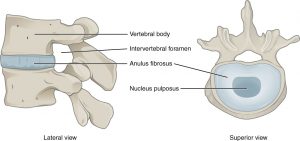Disc Bulges and Herniations.
Although very commonly associated with lower back back and injuries, it is important to understand two key points about disk bulges:
Not everyone who has lower back pain will have disc bulges.
Not everyone with disc bulges will have lower back pain.
When we understand these two points, it lets us separate the pain felt from the mechanical damage that has occurred to the discs, which in turn will let us understand the root of the issue.
What is a disk bulge?
To better understand disc bulges (so that we can understand their cause and hence begin to plan a successful rehab program), we need to get an understanding of the structure of the disc.
Each disc is a fibrocartilaginous joint, in that it allows slight movement of the vertebrae but also acts like a ligament holding two vertebrae together.

There are two main parts to its structure:
The tough out layer (annulus fibrosus) is composed of concentric sheets of collagen fibers (lamellae). In its simplest terms, this structure resembles that of the layers of an onion.
The inner core (nucleus pulposus), which contains a loose network of fibers suspended in a mucoprotein gel. Again, in very simple terms, imagine the jelly inside a jelly/jam doughnut.
So we have a softer gel filled nucleus, surrounded by tough but flexible collagen fibers.
Disc Bulge vs Disc Herniation
A disk bulge occurs when the nucleus leaks fluid through damaged layers of the annulus fibrosus and reaches the outer layer, causing it to expand, creating a disc bulge or protrusion.
The difference between a bulge (protrusion) and a herniation (slipped disc), is that the very outer layer of the annulus fibrosus has been broken and fluid from the nucleus can leak out of the disc.
This will cause the disc to lose height and give the disc that darkened appearance on MRI scans.
How is a Disc Bulge or Herniation Created?
The easiest way I have found to understand how bulges are created is to imagine holding a jam/jelly doughnut between your two hands.
Now imagine squeezing one end of the doughnut. You would expect that the jam/jelly inside would be squeezed out the opposite side in response to the pressure you are putting on the doughnut.
In a very simple way, this is what it happening to the damaged disc. Except rather than happening after a single squeeze, it takes years of excessive pressure and repeated compression to create the damage to the different fibrous layers and eventually create a bulge or leak.
Video: How Do You Get A Disc Bulge Or Herniation?

